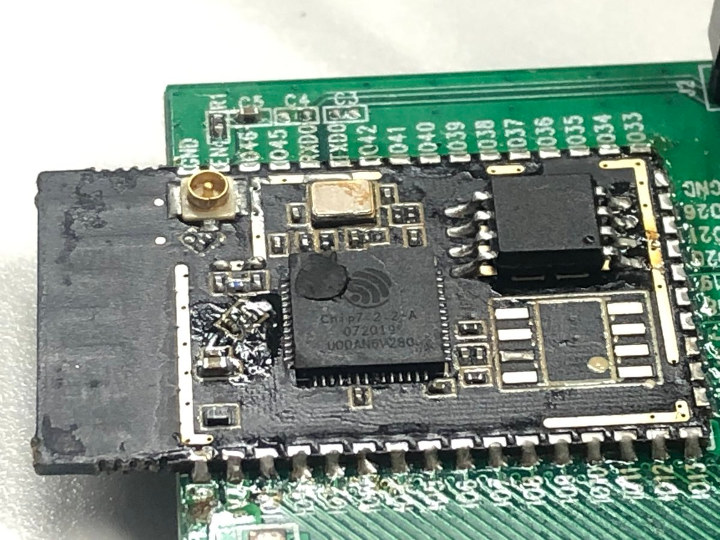Espressif Systems has not released any new chips since the launch of ESP32 WiFi & Bluetooth SoC in 2016. But it looks like an new chip may be right around the corner, as John Lee from Espressif Systems teased us with a photo featuring a module equipped with “Chip 7” that should be released “soonish”.

We really don’t know much about the chip except it comes in a 56-pin QFN package (4x 14 pins), and it won’t most likely be named Chip 7 once it is released.
One Twitter user left a comment mentioning that it “looks like a bodged RF Filter. 5GHz mod?”. This reminded me of the potential ESP32-D0CD / ESP32-D2CD processors with dual band (2.4 + 5 GHz) WiFi. When I say “potential” it simply refer to the fact that ESP32 nomenclature has a “CD” connectivity option for WiFi ac/c/b/g/n and Bluetooth dual mode. But Espressif never officially announced anything about ESP32-D0CD yet, and ESP32 chips are suppose to come in QFN48 packages, so “Chip 7” may be something completely new. We should find out soonish enough 🙂

Jean-Luc started CNX Software in 2010 as a part-time endeavor, before quitting his job as a software engineering manager, and starting to write daily news, and reviews full time later in 2011.
Support CNX Software! Donate via cryptocurrencies, become a Patron on Patreon, or purchase goods on Amazon or Aliexpress





If offers integrated Ethernet PHY, more GPIO and reliable SDK, might present interest. 5GHz WiFi is already available in MT7697D. Also, hope the ADC and other peripherals would be better.
I do not consider the current ESP32 SDK reliable for development as well as it seems that actually ESP32 even dual-core, performs slower in comparison to ESP8266.
Tested some time ago the ESP-IDF example file upload via WiFi, got the astonishing 10 kB/s. There are other implementations, but still much slower than what would be expected from WiFi connectivity.
@Dim, please note that theWiFi power-save (UAPSD) is by default enabled with ESP32 in ESP-IDF. If you want to do apple-to-apple comparison with ESP8266 or any other chip, you have to disable it and take the readings then.
I’m not the only one that produces scorched flux covered prototypes it seems. 😀
Would it kill them to wash it in IPA? 🙂
Legit question, is there any reason for cleaning it other than looking better?
I know some fluxes need cleaning to avoid board corrosion but I usually leave the residue from no-clean flux on the board (though it’s usually not as burnt as the one in the pic).
Doesn’t the no-clean stuff usually leave clear residue? The stuff on that board looks like the same tacky stuff I use and if you don’t clean that off it collects dirt from everywhere until you have a pcb shaped fur ball.
It’s conductive, so it can effect signals on the board. It’s also hygroscopic, so it picks up moisture from the environment–the effects its conductivity as well. It is, as you mention, corrosive. One of the good properties of glass fiber PCBs is that they don’t take up moisture and have temperature and moisture dependent properties.
There’s probably more reasons, but they tend to be things that you have to have happen to you before you realize it. Like getting flux on switch contacts, etc. “Oh, darn, why doesn’t the button work?”
> Like getting flux on switch contacts, etc.
>“Oh, darn, why doesn’t the button work?”
Add connectors to that. People often say you can’t have too much flux but when you get flux into a connector you can’t easily clean you’ll realise you really can have too much.
Chip 7 won’t support 5 GHz. John Lee replied “5 GHz is in the works. but not in this version”.
Some future ESP chips will be based on RISC-V instead of Tensilica.